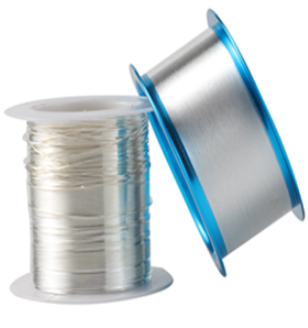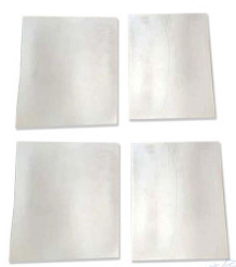Silver
Silver - Ag, a mineral of the class of native
elements, crystallizes in a cubic system, cubic-hexoctahedral symmetry.
It is found in argenites (sulfide) and horny silver (silver chloride),
and is also mined as a by-product of the purification of copper and
lead. Silver was one of the first metals mastered by man. It is an
excellent conductor of heat and electricity. Mexico is the main producer
of silver, although silver ores are scattered throughout the world.
The color is silver-white, often with yellow, brown or black tarnishing.
Silver from the surface oxidizes rather quickly in air and the faster,
the more impurities it contains, while the surface color changes to
black with a sheen of various shades. Luster metallic to matte, feature
silver-white, lustrous. Hardness 2.5 - 3. Density 9.6 -12. Cleavage is
absent, fracture is concave. Extremely pliable, flexible, malleable. It
has the highest thermal and electrical conductivity among metals. It is
a diamagnet. It melts easily under the soldering tube. Reacts with HCl,
forming a white curdled precipitate (AgCl). Reaction with H2S gives a
black coloration.
The formation of native silver in nature is in many ways similar to the
formation of copper. It, together with other silver-bearing minerals,
occurs in hydrothermal vein deposits in association with argentite
(Ag2S) and calcite (Kongsberg deposit in Norway), sometimes in
association with complex sulfurous, arsenic, antimony compounds of
various metals, including nickel and cobalt.
Under exogenous conditions, it, like native copper, is found in the
zones of oxidation of deposits of sulfurous and arsenic-antimony ores,
being a product of their decomposition and reduction from surface
solutions by various organic compounds. The native silver formed under
these conditions often has the form of dendrites, plates, mossy, wire,
hair-like forms, etc. connections.
Under surface conditions, native silver is less stable than gold. It is
often covered with black films and smears. In areas with a hot, dry
climate, it often transforms from the surface into stable halogen
compounds (AgCl, etc.).
Silver is mainly used in alloys with copper for making silver items,
coins, etc. Pure silver is used for filigree work, making crucibles for
melting alkalis, for silvering, for obtaining chemical compounds and
other purposes. The main mass of silver (about 80%) is mined not in
native form, but as a by-product from silver-rich lead-zinc, gold and
copper deposits.
The areas of application of silver are constantly expanding, and its use
is not only alloys, but also chemical compounds. A certain amount of
silver is constantly consumed for the production of silver-zinc and
silver-cadmium storage batteries, which have a very high energy density
and massive energy consumption and are capable of delivering very high
currents to the load with a low internal resistance.
.


Silver - Ag, a mineral of the class of native
elements, crystallizes in a cubic system, cubic-hexoctahedral symmetry.
It is found in argenites (sulfide) and horny silver (silver chloride),
and is also mined as a by-product of the purification of copper and
lead. Silver was one of the first metals mastered by man. It is an
excellent conductor of heat and electricity. Mexico is the main producer
of silver, although silver ores are scattered throughout the world.
The color is silver-white, often with yellow, brown or black tarnishing.
Silver from the surface oxidizes rather quickly in air and the faster,
the more impurities it contains, while the surface color changes to
black with a sheen of various shades. Luster metallic to matte, feature
silver-white, lustrous. Hardness 2.5 - 3. Density 9.6 -12. Cleavage is
absent, fracture is concave. Extremely pliable, flexible, malleable. It
has the highest thermal and electrical conductivity among metals. It is
a diamagnet. It melts easily under the soldering tube. Reacts with HCl,
forming a white curdled precipitate (AgCl). Reaction with H2S gives a
black coloration.
The formation of native silver in nature is in many ways similar to the
formation of copper. It, together with other silver-bearing minerals,
occurs in hydrothermal vein deposits in association with argentite
(Ag2S) and calcite (Kongsberg deposit in Norway), sometimes in
association with complex sulfurous, arsenic, antimony compounds of
various metals, including nickel and cobalt.
Under exogenous conditions, it, like native copper, is found in the
zones of oxidation of deposits of sulfurous and arsenic-antimony ores,
being a product of their decomposition and reduction from surface
solutions by various organic compounds. The native silver formed under
these conditions often has the form of dendrites, plates, mossy, wire,
hair-like forms, etc. connections.
Under surface conditions, native silver is less stable than gold. It is
often covered with black films and smears. In areas with a hot, dry
climate, it often transforms from the surface into stable halogen
compounds (AgCl, etc.).
Silver is mainly used in alloys with copper for making silver items,
coins, etc. Pure silver is used for filigree work, making crucibles for
melting alkalis, for silvering, for obtaining chemical compounds and
other purposes. The main mass of silver (about 80%) is mined not in
native form, but as a by-product from silver-rich lead-zinc, gold and
copper deposits.
The areas of application of silver are constantly expanding, and its use
is not only alloys, but also chemical compounds. A certain amount of
silver is constantly consumed for the production of silver-zinc and
silver-cadmium storage batteries, which have a very high energy density
and massive energy consumption and are capable of delivering very high
currents to the load with a low internal resistance.
.

|

|
